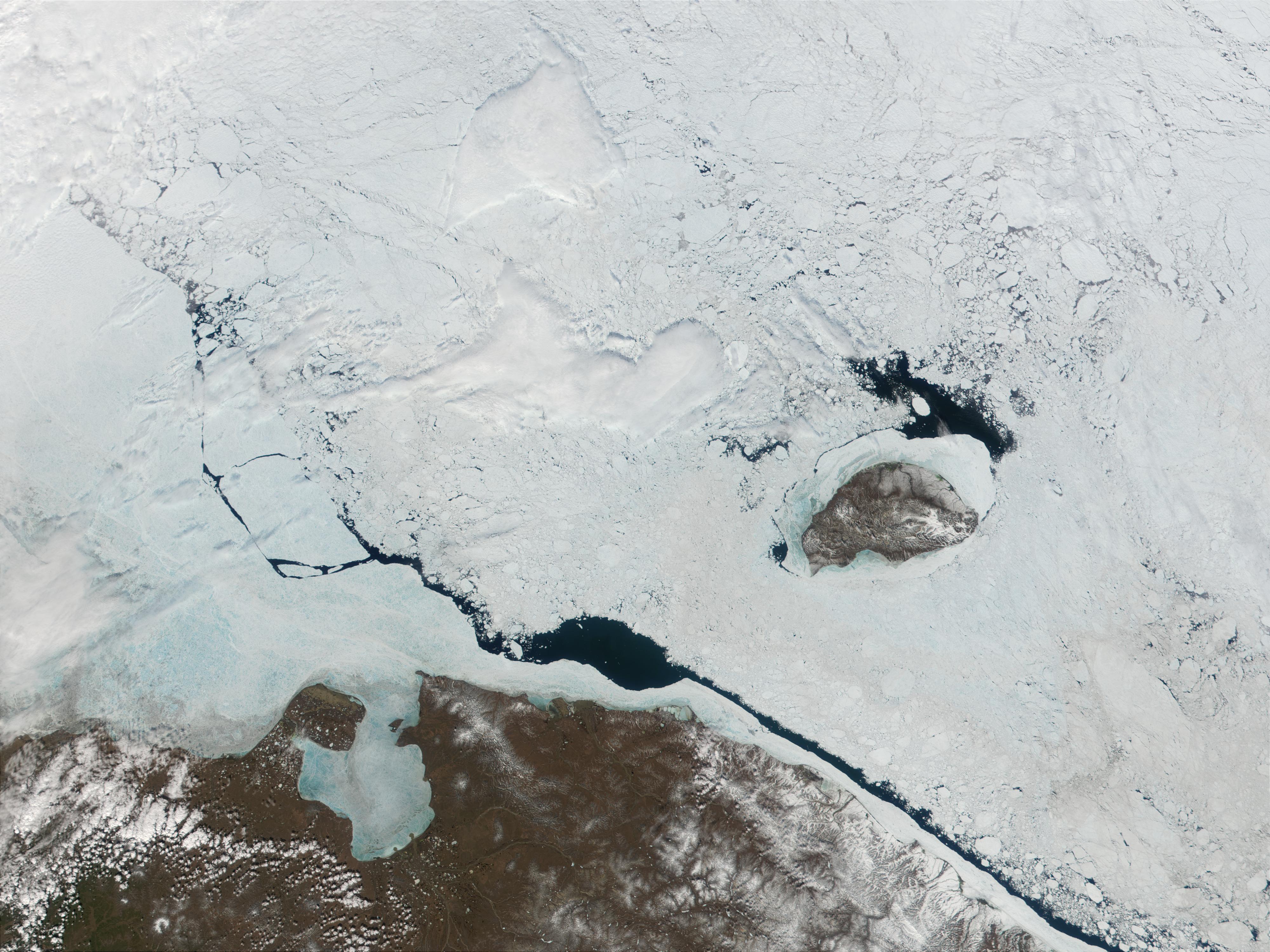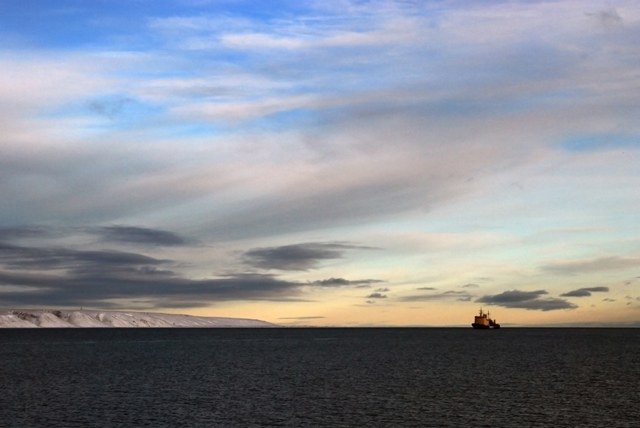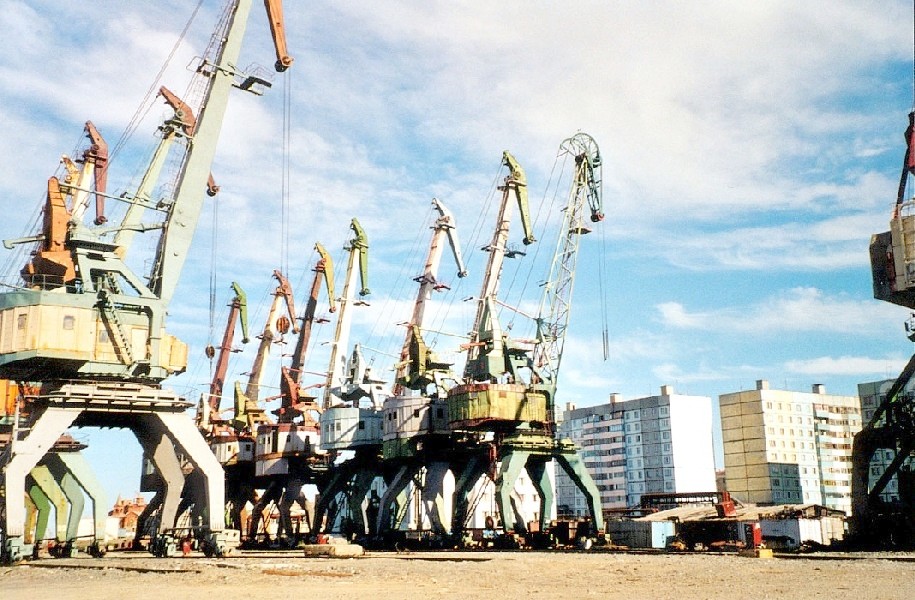|
Pevek
Pevek (russian: Певе́к; Chukchi: , ''Pèèkin'' / ''Pèèk'') is an Arctic port town and the administrative center of Chaunsky District in Chukotka Autonomous Okrug, Russia, located on Chaunskaya Bay (part of the East Siberian Sea) on a peninsula on the eastern side of the bay facing the Routan Islands, above the Arctic Circle, about northwest of Anadyr, the administrative center of the autonomous okrug. Population: Pevek is a modern settlement established after World War I to provide a port for the export of minerals as part of the expanding Northern Sea Route. During the 1940s and 1950s, the area surrounding Pevek was the site of several gulags where prisoners mined uranium. In recent years, many of the mines became unprofitable and have closed, causing many residents to move to more central regions in Russia and the port infrastructure to decay. Pevek is the present location of the Akademik Lomonosov floating nuclear power plant, which carries two marine-type KLT-40S ... [...More Info...] [...Related Items...] OR: [Wikipedia] [Google] [Baidu] |
Chaunsky District
Chaunsky District (russian: Ча́унский райо́н; Chukchi: , ''Čaan rajon'') is an administrativeLaw #33-OZ and municipalLaw #46-OZ district (raion), one of the six in Chukotka Autonomous Okrug, Russia. It is located on the northern shore of the autonomous okrug and borders with Iultinsky District in the northeast, Anadyrsky District in the southeast, and with Bilibinsky District in the south and west. The area of the district is . Its administrative center is the town of Pevek. Population: The population of Pevek accounts for 80.8% of the district's total population. Chaunsky District is flat compared to other districts in the autonomous okrug. The land within the current boundaries was first discovered by non-indigenous people in the 18th century, and now the indigenous people of the district are a minority as ethnic Russians came to the area following a growth in mining. Geography The district is centered around the Chaunskaya Bay, on the shores of which Pevek, ... [...More Info...] [...Related Items...] OR: [Wikipedia] [Google] [Baidu] |
East Siberian Sea
The East Siberian Sea ( rus, Восто́чно-Сиби́рское мо́ре, r=Vostochno-Sibirskoye more) is a marginal sea in the Arctic Ocean. It is located between the Arctic Cape to the north, the coast of Siberia to the south, the New Siberian Islands to the west and Cape Billings, close to Chukotka, and Wrangel Island to the east. This sea borders on the Laptev Sea to the west and the Chukchi Sea to the east. This sea is one of the least studied in the Arctic area. It is characterized by severe climate, low water salinity, and a scarcity of flora, fauna and human population, as well as shallow depths (mostly less than 50 m), slow sea currents, low tides (below 25 cm), frequent fogs, especially in summer, and an abundance of ice fields which fully melt only in August–September. The sea shores were inhabited for thousands of years by indigenous tribes of Yukaghirs, Chukchi and then Evens and Evenks, which were engaged in fishing, hunting and reindeer ... [...More Info...] [...Related Items...] OR: [Wikipedia] [Google] [Baidu] |
Chaunskaya Bay
The Chaunskaya Bay or Chaun Bay (russian: Чаунская губа) is an Arctic bay in the East Siberian Sea, in the Chaunsky District of Chukotka, northeast Siberia. There is Port of Pevek. Geography The bay is open to the north and is 140 km in length. Its maximum width is 110 km.GoogleEarth Its mouth is defined by Cape Shelagsky, the end of the Shelag Range, to the east and an unnamed part of Ayon Island to the west. It narrows where the Pevek Peninsula on the east approaches Ayon Island. Owing to is northerly location Chaunskaya Bay is covered with ice most of the year. This bay is the center of one of the larger lowlands in Chukotka. A number of rivers flow into the southeastern corner: Chaun River, Ichuveyem River, Palyavaam River, Lelyuveyem River and Pucheveyem River. There is a protected natural area in the southeast. Lake Elgygytgyn is about 160 km southeast and the town of Bilibino Bilibino (russian: Били́бино) is a town and the ... [...More Info...] [...Related Items...] OR: [Wikipedia] [Google] [Baidu] |
Akademik Lomonosov
''Akademik Lomonosov'' (russian: Академик Ломоносов) is a non-self-propelled power barge that operates as the first Russian floating nuclear power station. The ship was named after academician Mikhail Lomonosov. It is docked in the Pevek harbour, providing heat to the town and supplying electricity to the regional Chaun-Bilibino power system. It is the world’s northernmost nuclear power plant. History Construction started at the Sevmash Submarine-Building Plant in Severodvinsk. The keel of ''Akademik Lomonosov'' was laid on 15 April 2007 and completion was initially planned in May 2010. The celebrations were attended by the first deputy prime minister of Russia, Sergei Ivanov, and by the head of Rosatom, Sergei Kiriyenko. In August 2008, the Russian government approved the transfer of work from Sevmash to the Baltic Shipyard (Baltiysky Zavod) in Saint Petersburg. A second keel-laying was done at the new shipyard in May 2009. ''Akademik Lomonosov'' was launc ... [...More Info...] [...Related Items...] OR: [Wikipedia] [Google] [Baidu] |
Routan Islands
The Routan Islands ( ckt, Ровтын иӆирти ''Rovtįn iłirti'') are two islands in the eastern coast of the Chaunskaya Bay of the East Siberian Sea. They are located directly off Pevek, separated from the shore of the Pevek Peninsula by a 4.7 km wide sound. Ayon Island lies on the other side of the Chaunskaya Bay, 24 km to the west. * Bolshoy Routan Island (Russian: Остров Большой Роутан) is roughly triangular. It is 9.5 km long and 4.5 km wide. A small Arctic Station is located on the island. * Malyy Routan Island (russian: Остров Ма́лый Роутан) is much smaller and lies 1 km to the west of Bolshoy Routan's southern point. It is only 1.3 km in length. Administratively these islands belong to the Chukotka Autonomous Okrug of the Russian Federation. See also * List of islands of Russia A ''list'' is any set of items in a row. List or lists may also refer to: People * List (surname) Organizatio ... [...More Info...] [...Related Items...] OR: [Wikipedia] [Google] [Baidu] |
Chukotka Autonomous Okrug
Chukotka (russian: Чуко́тка), officially the Chukotka Autonomous Okrug,, ''Čukotkakèn avtonomnykèn okrug'', is the easternmost federal subjects of Russia, federal subject of Russia. It is an autonomous okrug situated in the Russian Far East, and shares a border with the Sakha, Sakha Republic to the west, Magadan Oblast to the south-west, and Kamchatka Krai to the south. Anadyr (town), Anadyr is the largest types of inhabited localities in Russia, town and the administrative center, capital, and the easternmost settlement to have town status in Russia. Chukotka is primarily populated by ethnic Russians, Chukchi people, Chukchi, and other Indigenous peoples of Siberia, indigenous peoples. It is the only autonomous okrug in Russia that is not included in, or subordinate to, another federal subject, having separated from Magadan Oblast in 1992. It is home to Lake Elgygytgyn, an impact crater lake, and Anyuyskiy, an extinct volcano. The village of Uelen is the easternmos ... [...More Info...] [...Related Items...] OR: [Wikipedia] [Google] [Baidu] |
Krasnoarmeysky, Chukotka Autonomous Okrug
Krasnoarmeysky (russian: Красноармейский, literally ''Red Army''; ckt, Пырӄаӄай, ''Pyrḳaḳaj'') was an inhabited locality (an urban-type settlement) in Chaunsky District of Chukotka Autonomous Okrug, Russia. Population: 0 ( 2002 Census); History The settlement was founded in March 1940 on the banks of the Pyrkanayvaam River, 100 km from Pevek to house the miners and administrative workers from the Pyrkakay (russian: Пыркакай) tin mine, with the name being changed to Krasnoarmeysky in January 1942 to honour the victories of the Red Army. It was given settlement status in 1953, but was determined to no longer be economically viable in 1998. As of 2009, Krasnoarmeysky is included in the list of settlements currently in the process of being liquidated.Law #33, Article 14.2 Population The mines were declared unprofitable and that there was no possibility of developing any other form of economy in 1999 and the settlement was closed along ... [...More Info...] [...Related Items...] OR: [Wikipedia] [Google] [Baidu] |
Murmansk
Murmansk (Russian: ''Мурманск'' lit. "Norwegian coast"; Finnish: ''Murmansk'', sometimes ''Muurmanski'', previously ''Muurmanni''; Norwegian: ''Norskekysten;'' Northern Sámi: ''Murmánska;'' Kildin Sámi: ''Мурман ланнҍ'') is a port city and the administrative center of Murmansk Oblast in the far northwest part of Russia. It sits on both slopes and banks of a modest ria or fjord, Kola Bay, an estuarine inlet of the Barents Sea. Its bulk is on the east bank of the inlet. It is in the north of the rounded Kola Peninsula which covers most of the oblast. The city is from the border with Norway and from the Finnish border. The city is named for the Murman Coast, which is in turn derived from an archaic term in Russian for "Norwegian". Benefiting from the North Atlantic Current, Murmansk resembles cities of its size across western Russia, with highway and railway access to the rest of Europe, and the northernmost trolleybus system on Earth. It lies o ... [...More Info...] [...Related Items...] OR: [Wikipedia] [Google] [Baidu] |
Dissolution Of The Soviet Union
The dissolution of the Soviet Union, also negatively connoted as rus, Разва́л Сове́тского Сою́за, r=Razvál Sovétskogo Soyúza, ''Ruining of the Soviet Union''. was the process of internal disintegration within the Soviet Union (USSR) which resulted in the end of the country's and its federal government's existence as a sovereign state, thereby resulting in its constituent republics gaining full sovereignty on 26 December 1991. It brought an end to General Secretary Mikhail Gorbachev's (later also President) effort to reform the Soviet political and economic system in an attempt to stop a period of political stalemate and economic backslide. The Soviet Union had experienced internal stagnation and ethnic separatism. Although highly centralized until its final years, the country was made up of fifteen top-level republics that served as homelands for different ethnicities. By late 1991, amid a catastrophic political crisis, with several republics alr ... [...More Info...] [...Related Items...] OR: [Wikipedia] [Google] [Baidu] |
Dudinka
Dudinka (russian: Дуди́нка; Nenets: Тут'ын, ''Tutꜧyn'') is a town on the Yenisei River and the administrative center of Taymyrsky Dolgano-Nenetsky District of Krasnoyarsk Krai, Russia. It used to be the administrative center of Taymyr Autonomous Okrug, which was merged into Krasnoyarsk Krai on January 1, 2007. Population: History It was founded in 1667 as a winter settlement connected to Mangazeya. In 1930 it was designated the administrative center of the Taimyr Dolgan-Nenets National Region. In 1935, the polar explorer Otto Schmidt recommended that the settlement be expanded into a town. By 1937, the port facilities and a railroad to Norilsk were completed. Town status was granted in 1951. Administrative and municipal status Within the framework of administrative divisions, Dudinka serves as the administrative center of Taymyrsky Dolgano-Nenetsky District.Law #10-4765 As an administrative division, it is, together with five rural localities, incorporat ... [...More Info...] [...Related Items...] OR: [Wikipedia] [Google] [Baidu] |
Vladivostok
Vladivostok ( rus, Владивосто́к, a=Владивосток.ogg, p=vɫədʲɪvɐˈstok) is the largest city and the administrative center of Primorsky Krai, Russia. The city is located around the Golden Horn Bay on the Sea of Japan, covering an area of , with a population of 600,871 residents as of 2021. Vladivostok is the second-largest city in the Far Eastern Federal District, as well as the Russian Far East, after Khabarovsk. Shortly after the signing of the Treaty of Aigun, the city was founded on July 2, 1860 as a Russian military outpost on formerly Chinese land. In 1872, the main Russian naval base on the Pacific Ocean was transferred to the city, stimulating the growth of modern Vladivostok. After the outbreak of the Russian Revolution in 1917, Vladivostok was occupied in 1918 by White Russian and Allied forces, the last of whom from Japan were not withdrawn until 1922; by that time the antirevolutionary White Army forces in Vladivostok promptly collapsed, an ... [...More Info...] [...Related Items...] OR: [Wikipedia] [Google] [Baidu] |
Great Northern Expedition
The Great Northern Expedition (russian: Великая Северная экспедиция) or Second Kamchatka Expedition (russian: Вторая Камчатская экспедиция) was one of the largest exploration enterprises in history, mapping most of the Arctic coast of Siberia and some parts of the North American coastline, greatly reducing "white areas" on maps. It was conceived by Russian Emperor Peter the Great, but implemented by Russian Empresses Anna and Elizabeth. The main organiser and leader of the expedition was Vitus Bering, who earlier had been commissioned by Peter I to lead the First Kamchatka Expedition (1725 to 1731). The Second Kamchatka Expedition lasted roughly from 1733 to 1743 and later was called the Great Northern Expedition due to the immense scale of its achievements. The goal was to find and map the eastern reaches of Siberia, and hopefully the western shores of North America. Peter I had a vision for the 18th-century Russian Navy ... [...More Info...] [...Related Items...] OR: [Wikipedia] [Google] [Baidu] |





.jpg)


